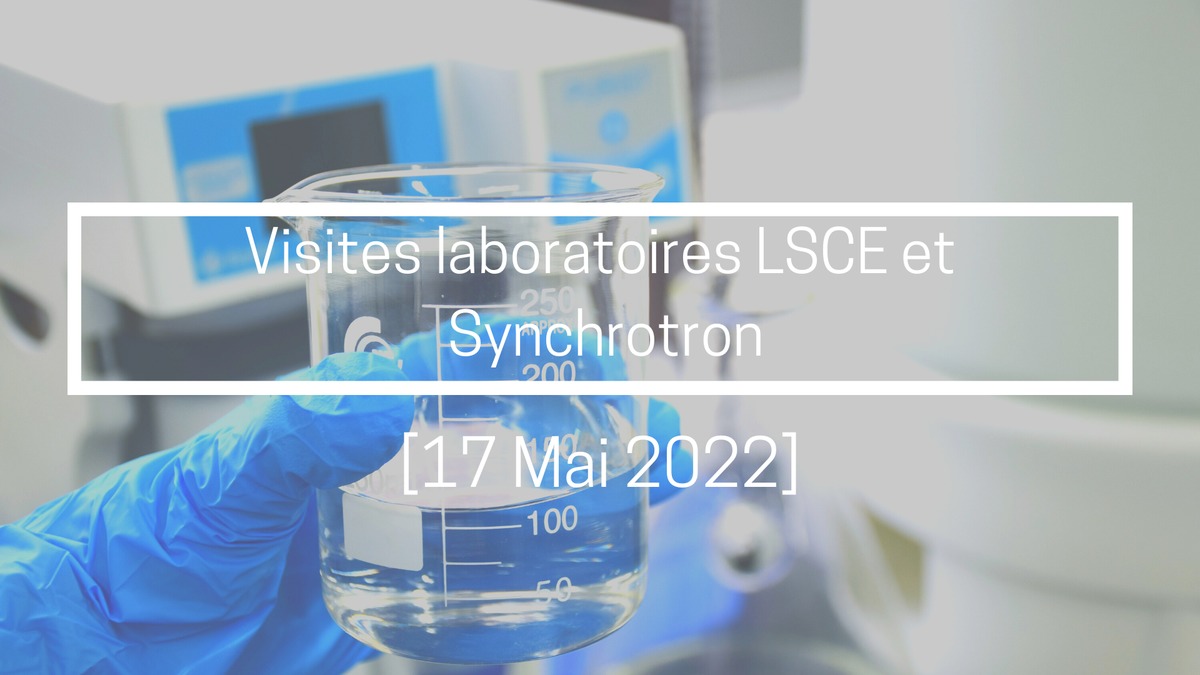Visit of the SOLEIL Synchrotron center with the EMS cluster
On 05/17/2022 from 2:00 p.m. to 4:30 p.m.

Visits with the EMS Cluster – Tuesday May 17, 2022 – 8:30 a.m. to 5:00 p.m.
Visit LSCE laboratories | 8:30 a.m. – 1 p.m.
Number of places limited to 30 for laboratory visits
AMPHI BLOCH, Building 772 at a place called L'Orme des Merisiers, site of the CEA Saclay research center (Route de l'Orme, city of Saint-Aubin, 91190)
Climate and Environmental Sciences Laboratory
8:30 a.m. – 9:00 a.m.: Reception of guests – breakfast
9:00 a.m.: Back to the PCAET workshops – Presentation of the lab
9:30 a.m. – 12:15 p.m.: Visits to the desired laboratories (4 visits per person of your choice, please register)
12.15 p.m. – 1 p.m.: Presentation of visitors and debriefing on the morning.
1-2 p.m.: Picnic
2:30 p.m. – Synchrotron
2:30 p.m. - 3:15 p.m.: General presentation with examples of applications in the field of the environment and eco-activities
3:15-3:30 p.m.: Questions answers
3:30-5:00 p.m.: Visit in 2 or 3 groups of 10 people (depending on the number of participants) on the beamlines


Visit with the EMS Cluster
Visit with the EMS Cluster
SUN is a very high-tech research infrastructure producing and exploiting extremely bright light, from THz to hard X-rays, to study living matter and complex materials.
Equipped with 29 specialized laboratories called beamlines, SUN is a center for scientific research and services to research and industry covering numerous scientific disciplines and industrial sectors.
Each line of light uses the exceptional properties of synchrotron light (continuity and tunability of energy from far infrared to hard X-rays, extreme brilliance, low divergence, polarization, coherence, etc.) to access the finest characteristics and the most varied (electronic, magnetic, chemical, structural or morphological information) of the materials studied. Thus the use of synchrotron techniques makes it possible to offer increased performance compared to conventional photonic techniques (spectroscopy, diffraction, imaging, tomography and on the other hand to access additional information thanks to specific techniques of synchrotron light (absorption rays, X-ray microscopy, etc.).
See description of the laboratories HERE | Registration for laboratory visits

Visit with the EMS Cluster
SMIS is one of SOLEIL's two infrared spectroscopy lines. The specificity of this beamline is to provide a high brightness source in the ~1 – 200 µm spectral region, with optimization in the 2.5 – 50 µm region, coupled with an infrared microscope. This line of infrared imaging responds to many problems (particularly in biology, in the biomedical field and that of geosciences). A team (GME from the MICALIS Institute (INRAE/AgroParisTech), UMR 800 (CNRS/Physical Chemistry Institute, Paris-Saclay University) recently carried out on this beamline using hyperspectral IR imaging coupled with an isotopic technique, a study to validate and invalidate hypotheses on the biodegradation of polyethylene by larvae. This beamline is also currently carrying out studies on plant roots and their ability to absorb dangerous metals or their interaction with rhizomes. The line also recently carried out a study on the analysis of agricultural soil particles and the Amazonian forest, which are particularly rich in organic matter.

Visit with the EMS Cluster
" LUCIA » (Ligneous Uused for the VScharacterization by Imagician and ATbsorption) is the SOLEIL beamline dedicated to X-ray micro-absorption (μ-XAS) and X-ray micro-fluorescence (μ-XRF) experiments in the field of so-called “soft” X-rays (0.5 – 8.0 keV). The coupling of these two techniques applies to the measurement of heterogeneous samples at the micron scale. Conventionally, elementary maps are produced in µXRF at the scale of the photon spot (~3 x 3 µm) (possibly at different incident beam energies, taking advantage of the tunable monochromatic beam). The information obtained makes it possible to determine the location of the elements and their relative abundance. The local environment (electronic and structural) around a given element can then be described by collecting spectra of µXAS (µXANES and/or µEXAFS) at points of interest defined from the elementary map. The energy range offered by LUCIA allows XAS experiments at the K-edge of elements from fluorine (F) to cobalt (Co) and at the L-edges of chromium (Cr) to dysprosium (Dy) as well as at the M lanthanides and actinides. LUCIA offers many applications in the environmental field. For example, the fate of metallic pollutants in a soil can be studied by µXRF-XAS coupling. It makes it possible to determine the mineral phases with which the pollutants are associated as well as their mode of association (ie adsorbed on the surface or incorporated into the structure), which is a major parameter controlling their mobility and their (bio)availability. The carrier phase of the pollutant can also be characterized, such as colloidal structures that can transport pollutants over long distances in surface waters. This technique can be applied, among other things, to the study of the fate of emerging pollutants such as rare earths or micro and nano-plastics.

Visit with the EMS Cluster
SAMBA (Spectroscopy ATapplied to Mmaterial Based on ATbsorption) is an absorption line in the hard X-ray region. SAMBA is open to a vast scientific community ranging from physics to chemistry, surface and environmental sciences, as well as to companies in various sectors (chemistry, energy, construction, environment, etc.). The optical scheme of the line is optimized to be very versatile and cover the range from 4.8 to 40 keV with high photon flux, stability and optimal resolution. The monochromator operates in continuous scan mode and an HPGe detector with 35 pixels is available for measurements on highly dilute species. The line is particularly well suited to the study of ETM micropollutants (for example the speciation of lead, mercury, antimony, cadmium, etc.) or any other element in natural systems (soils, sediments, snow, plants, micro-organisms, etc.). .
